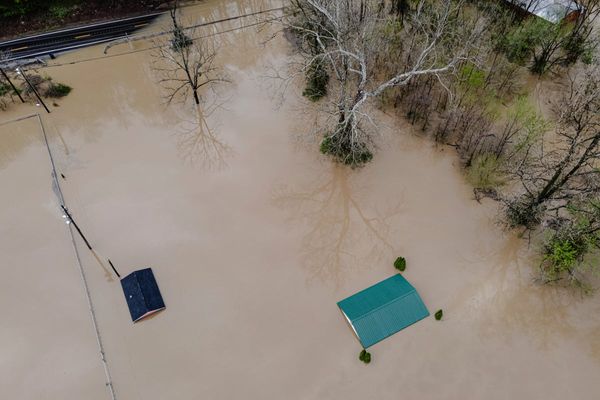
Independent MPs Allegra Spender and Zali Steggall are pushing the government to include an absolute cap or an explicit objective that emissions must come down under the safeguard mechanism.
And Spender is publicly insisting Labor has not ruled out a “carbon budget” for big emitters.
While the climate change minister, Chris Bowen, has designed the scheme to be open to new entrants and has ruled out the Greens request for a ban on new coal and gas, the crossbench, including the balance of power senator David Pocock, wants to ensure industries reduce overall emissions.
Despite modelling by the consultants RepuTex suggesting new projects could cause an emissions “blowout” under the safeguard if they produce more coal or gas than forecast, in a speech to the Sydney Institute on Monday Bowen argued the scheme will deliver 205m tonnes of emissions abatement.
Bowen said he understood “the emphasis on possible new facilities in the public debate”, but the safeguard mechanism was “about reducing emissions from all facilities: old and new, industrial and resources-based”.
“The fact is this: if our reforms are passed, there will be a scheme to ensure emissions come down from big emitters, whether they be old or new,” he said. “If they don’t pass, there will be no such scheme. It will be business as usual.”
The safeguard mechanism was introduced by the Coalition in 2016. It was promised to put a limit on greenhouse gas emissions from about 200 major industrial facilities.
It applies to facilities that emit more than 100,000 tonnes of carbon dioxide equivalent a year. Each facility is set an emissions limit, known as a baseline.
The Coalition said companies that emitted above their baseline would have to buy carbon offsets or pay a penalty. In practice, facilities were allowed to change their baselines, few were penalised and industrial emissions continued to increase.
Labor plans to revamp the scheme.
It would set new baselines based on emissions intensity – how much a facility releases per unit of production. Baselines will be reduced by 4.9% a year.
Companies could choose whether to make onsite emissions cuts or buy Australian carbon credit units.
New polluting facilities, including gas and coalmines, could open and would be set baselines at “international best practice”.
Companies that emit less pollution than their baseline allows would be awarded a new type of “safeguard credit”. These within-scheme credits could be sold to other polluting facilities that emit more than their baseline and need offsets.
Labor wants the changes to start on 1 July 2023.
In a parliamentary inquiry report last week, Pocock called for the inclusion of “an absolute cap” on emissions to ensure that the government’s goal of no more than 1,233m tonnes of CO2 was released from the facilities covered by the scheme between 2021 and 2030, an amendment that has also been moved by Spender.
Spender said the goal was “to make sure the safeguard mechanism actually delivers a reduction in emissions” despite the possibility of new entrants.
“I’m in constructive conversations with the minister,” she told Guardian Australia. “My goal is … to truly deliver on decarbonisation. On this one, it’s certainly a conversation we’re having.”
Bowen last week told ABC’s 7:30 that “a lot of those proposals [for new entrants] are factored in and we still get 205m tonnes of abatement”.
“Secondly, in addition to that, we’ve factored in what we call a reserve, if you like, a buffer of an extra 17m tonnes, in case an existing facility increases production or more new facilities come on,” he said.
Steggall said the intent of the bill was good, but the crossbench was concerned about new entrants, the unlimited use of offsets, and improving the measurement of fugitive methane emissions.
She has proposed adding an objective for emissions to decline – not a hard cap – accepting that there “may be a reluctance” from the government “to be locked into a scenario that creates difficulties”.
“The reality is we do need our gross emissions to go down … If not, we’re on a hiding to nothing if we keep increasing emissions but we offset,” Steggall said.
Spender has also proposed abandoning a price cap on carbon offsets, planned to start at $75 a tonne of CO2, as a way to create “sharp incentives” to invest in their own abatements.
She urged the government to abandon its approach of “sectoral blindness”, warning that industries in which emissions cuts were difficult, such as cement and aluminium, could become “uncompetitive” if they were forced to shoulder a bigger burden to allow new coal and gas developments.
Crossbench parliamentarians have seized on Bowen’s remarks that “new facilities will be obliged to comply with the world’s best practice on emissions” as an indication that higher standards on emissions intensity or limits on offsets could be applied to them.
Bowen told the Sydney Institute the safeguard mechanism “incentivises onsite emissions reduction” by giving companies credits for coming in under their emissions ceiling.
Bowen said the government’s goal of cutting emissions intensity for most facilities by 4.9% each year was “ambitious” but “achievable”.
“Because of that level of ambition, and the breadth and variety of sectors covered, it’s necessary to provide flexibility to industries to ensure that ambition is achievable,” he said.







